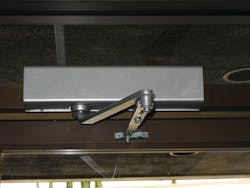Retrofit Surface-Mount Door Closers: Where, When and Why?
Surface-mounted door closers come in many sizes and the covers usually have different shapes, finishes and molded designs. Door closers are normally installed onto the secured side of door for at least two reasons. First, a door with a box and an arm extending from the surface is not aesthetically pleasing. Second, there is usually less likelihood that the door closer will be vandalized when installed onto the secured side.
However, this reason does not seem to be valid in K-12 grade schools as well as some colleges.
There is an advantage that adjacent doors do not have visible surface mounted door closers. They do, however, have visible locks. When you walk down a hallway, a door with a different lock will sometimes standout like a sore thumb. Unless the door closers are mounted on the exterior, no one is going to notice or compare if one is different from another. They will notice if the door has multiple sets of mounting holes with sex bolts.
For the purpose of this article, we will discuss a couple scenarios of being called about a no longer operating surface-mount door closer. Each scenario will determine how we proceed with the door closer replacement.
Note: To somewhat simplify the article; we will assume the door closer is no longer under the manufacturer’s warranty. We will also assume the door closer is mounted onto the secured side.
Scenario 1: Hollow Metal Door
For the first scenario, the surface-mount door closer is installed onto a hollow metal door. We examine the edges of the door and jamb and determine there is no fire label. Hollow metal doors for general use are available with 20, 18 and 16 gauge steel faces. To accommodate a surface-mounted door closer, manufacturers can add re-enforcement, usually about 14 gauge steel. The closer reinforcing prevents the door faces from compressing when the unit is mounted.
We see that there are no sex nuts on the door face opposite the installed unit. We remove the door closer and find out that the mounting holes are threaded.
Once the make and model of the door closer is determined, we check to see if it is still in production. For this scenario, the door closer is still available and the replacement price is agreeable to the customer. We’ll replace the door closer with the same manufacturer and model. There is no need to drill any new holes or modify the door or jamb.
Scenario 2: Solid Wood Door
For the second scenario, the surface-mounted door closer is mounted onto a solid wood door. A solid wood door does not have hollow spaces. The door can be manufactured of lumber or engineered having a veneer and frame filling the interior with wood materials like sawdust and chips with adhesives to form a composite material.
The door closer is through bolted using sex nuts. We examine the edges of the door and jamb and determine there is no fire label. The door has been stained, having a natural finish. Unfortunately, the door closer has been discontinued. The finish on the through-bolted door makes it just plain wrong to drill additional holes in order to accommodate a different footprint door closer.
Some door closers have become so popular that other companies manufacture a very similar unit with the same bolt hole pattern.
To find a similar surface-mount door closer with the same bolt hole pattern, there are three measurements to determine unless you are able to physically place one closer over another to match the bolt hole openings.
Most surface-mount door closers are mounted using four bolts or screws. The four holes are normally two vertical sets of two. The manufacturer and the shape of the closer body determine the locations of the bolt holes.
To determine the pattern, measure the distance between each of the two centers of the holes horizontally. Then measure the distance between the centers of the holes vertically. The third measurement is the distance from the closest vertical hole and the center of the spindle. This distance will give you some understanding of the location of the spindle for each closer.
When looking for a replacement door closer, try to find one whose hole pattern is the same as the positioning of the through bolts in the door are not really adjustable.
The reason to through bolt a surface-mount door closer onto a wood door is to ensure the closer remains in place. When mounting the door closer using wood screws, over time the holes enlarge because pressure is exerted against the screws each time the door is opened and closed.
If you are installing a surface-mount door closer on a hollow core door, make sure that at least the two upper mounting holes are within the top rail of the door. If not, it can be difficult to secure the closer onto the door without damaging the veneer.
A suggestion when mount a door closer onto a hollow core wood door is to use non-hardening thread adhesive. The thread adhesive will keep the screws secured in the sex nut, but will permit the screws to be removed relatively easily.
Note: For some direct replacement retrofit plates, new holes may have to be drilled for mounting the arm bracket.
If a replacement door closer is not available, several manufacturers offer a specific application retrofit plates for door closer without modifying the existing hole pattern in the door. For example, the Norton RP75-M2020 Retrofit Plate has countersunk screw holes for installing the plate onto the door using the existing Rixson M2020 Door Closer mounting holes. There are threaded holes for mounting the Norton 7500 Series Door Closers onto the plate.
Design Hardware Retrofit Door Closer
In addition to specific manufacturer and model retrofit plates, Design Hardware produces the 316R Series Replacement Door Closer. This surface-mount door closer has the patented Mounting Plate that can retrofit 32 different makes and models of surface mount door closers without drilling new mounting holes. To accommodate these door closers, the Mounting Plate has 24 holes and can be installed using the front or the backside. The holes are counter-sunk on both sides to accommodate Right Hand/ Left Hand Reverse and Left Hand/Right Hand Reverse installations.
The Mounting Plate from the 316R door closer is designed to retrofit the following door closer models*:
- Corbin Russwin 3200, 3600, 6200, 6400
- Design Hardware 116, 316, 416
- Dorma 7200, 7300, 8600
- Dor-O-Matic SC60, SC70, SC80
- LCN 4041, 4110, 1460
- Norton 1600, 7500, 7700, 8100, 8300, 8500
- Ryobi 1650, 3500, 4500
- Sargent 1430
- Yale 50, 150, 400, 3100, 3300, 3500, 4400
*Using Regular Arm, Top Jam and Parallel Arm installation.
The Design Hardware 316R Series Replacement Door Closer meets ANSI A156.4 – Grade 1 Standards. This rack and pinion style door closer door closer has a UL Listing “A” label for installation onto a 3 hour fire door, and has the UL10C Positive Pressure rating. This non-handed closer has a cast aluminum body and heat treated steel piston, spring and spindle. The size one to six adjustable spring power door closer is able to meet the five pound opening restrictions.
An advantage of stocking the Design Hardware 316R Series Replacement Door Closer is if the door closer that needs to be replaced is one of the above listed models, the job can be completed immediately. There’s no need to go and pickup a replacement door closer or find a retrofit plate.
Installation
To complete this article, I was invited to observe the installation of the Design Hardware 316R Series Replacement Door Closer onto narrow stile aluminum glass door. This outswing double door entry is the front entrance for an engineering facility.
Important: Whenever you are installing a device onto a rated door, and are required to make modification, discuss the installation with an Authority Having Jurisdiction (AHJ) prior to the purchase and installation.
The two door closers were installing using the Top Jamb configuration, having the door closer body mounted onto the interior side of the aluminum surround frame with the door closer shoe installed onto the door.
This was not the first door closer body to be mounted onto the aluminum surround frame. More than one dozen holes had been drilled into the frame. The shoe was secured to the door using sex nuts and screws. There were three holes; two had been enlarged, probably in order to align with the sex nuts. A third hole between the two had been drilled for some reason.
The 316R shoe has three holes to adjust the operating angle. The original shoe has two holes. This would not affect the overall operation as the horizontal mounting instructions between the two door closers varied by about one inch.
The original door closer shoe mounting holes were slightly farther apart than the 316R shoe mounting holes. Because of the oversized holes, there was no way to easily drill a second hole to accommodate the 316R shoe. The shoe arm swivel bushing was the same diameter and flat, making it easier to be able to interchange parts.
Since the two shoes and adjustable arms are very similar in design, they modified the height of the shoe swivel pivot using a grinding wheel in order for the 316R arm to slip into the existing door closer shoe.
The plate was mounted onto the door in the proper direction for the mounting holes in the surround frame. Four supplied Phillips head screws were installed using non-hardening thread adhesive.
The door closer body was installed onto the plate using the supplied Phillips Head screws. The swivel arm length was adjusted to enable the arm to be in the proper position when the door is closed. To gain the proper closing force, the closer arm was pre-loaded according to the instructions by attaching an adjustable wrench onto the upper end of the spindle.
Once the arm assembly was mounted and adjusted to 90 degrees, the next steps were to adjust spring power, sweep and latch, and backcheck. There is no doorstop for this door. Since there is no latch bolt on this door, adjustment was relatively simple. The door was opened a number of times to enable the door closer to be adjusted to properly close the door. The pre-load provided sufficient force to not allow the door to swing open as a result of HVAC pressure.
As more door closer are having longer life expectancy and new models are being introduced, replacing older operating units is becoming more difficult. Keeping a record of the door closers installed for your customers or knowing the door closers as a result of a site survey can provide sufficient information that can enable a single service call to determine the problem with a door closer and be able to replace it if necessary.
For more information on the Design Hardware 316R Series Replacement Door Closer, contact your local locksmith distributor or Design Hardware, 211 Endeavor Drive, Rogersville, MO 65742. Telephone: 877-258-1262. Web Site: www.designhardware.net.
Time to Install: Approximately 45 minutes to one hour
Tools Required: Screwdrivers, ladder, adjustable wrench, thread adhesive
Warranty: Limited lifetime warranty
About the Author

